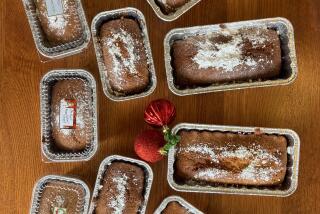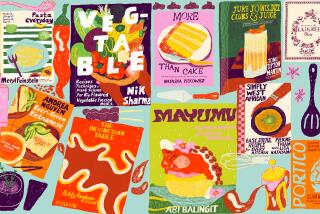With a pinch of nostalgia
- Share via
The baking season has arrived, and so has a new reason to heat the oven: an inviting cookbook called “Baking in America” by Greg Patent (Houghton Mifflin, 2002, $35).
Its recipes are the sort that inspire nostalgia. Their titles are homey and comforting in their simplicity: chewy butterscotch loaf, lemon-honey drop cookies, buttermilk bread ...
You’ll find American favorites in other cookbooks, but “Baking in America” offers recipes closer to their origins. It’s fun for an avid baker who’s made Boston cream pies or spongecakes many times before to try vintage versions (with the benefit of adaptations for the modern kitchen). And it’s just as fun to read about how they came to be our favorites today.
Patent sifted through two centuries’ worth of American cookbooks, journals and other recipe collections. He traced the classics, searched for forgotten gems and listened to the wisdom of bakers past. He then returned to his own kitchen and emerged with a collection of recipes spanning a nation’s lifetime and the stories behind them.
“Baking in America” begins with savory breads, but not long into the second chapter, it turns its attention to sweet goods and never looks back. All along the 12 chapters -- through layer cakes, cream puffs, cheesecakes and pies -- the book offers heaps of reassuring advice as well as glimpses of the past both relevant and amusing.
Making the sour cream lemon pound cake? (If not, you should be -- it’s exceptional.) Listen to Mrs. Crowen pontificate in 1850 about the benefit of beating the butter and sugar to a light cream. And should you think that a Boston cream pie isn’t worthy of its name without a chocolate glaze, thank Betty Crocker (or at least the folks behind the fictitious cooking maven) for adding that now-ubiquitous touch in 1950, nearly a century after the classic cake’s inception.
An American touch
The book’s recipes include culinary firsts (America’s earliest cookbook recipe for a chocolate cake, for example), Pillsbury Bake-Off winners and regional favorites with a distinctively American touch. But just as notable are Patent’s own creations. They are proof that the “American tradition of improvisation,” as the author calls it, is alive and well.
And thank goodness. For although it is interesting to try a gingerbread recipe from 1851 (a bit drier and more cake-like than what we’re used to, which is perhaps why Patent suggests serving it with a dollop of cream), our modern tastes are grateful for the innovation of bakers and the arrival of other ingredients into our pantries. Take Patent’s sophisticated ginger cupcakes: Three forms of the well-loved spice -- fresh, powdered and crystallized -- join forces in a moist, tender-crumbed cake, which is then crowned with a luxurious white chocolate ganache.
A onetime zoology professor and a lifelong baker, Patent gives us recipes with meticulous instructions. And at the outset, he devotes several pages to ingredients and equipment, enlightening the novice but also teaching the more experienced a thing or two.
“Baking in America” makes a fine effort to ensure that the line of bakers continues. Long live an American tradition indeed.
*
Ginger cupcake triple play
Total time: 1 hour
Servings: 14
Note: These can also be baked in mini-muffin pans. Bake for 15 minutes; use a butter knife to spread the frosting on top.
Cupcakes
1 3/4 cups sifted cake flour
1/2 teaspoon baking soda
1/4 teaspoon salt
1 teaspoon ground ginger
1/2 teaspoon allspice
1/2 cup (1 stick) unsalted butter, at room temperature
1 teaspoon vanilla extract
1 (1-inch) piece fresh ginger root, finely grated (plus any juice)
Finely grated zest of 1 orange
1cup light brown sugar, packed
1egg
3/4 cup buttermilk
About 1/4- 1/3 cup finely chopped crystallized ginger
1. Adjust an oven rack to the lower-third position and heat the oven to 350 degrees. Line 14 muffin cups with paper liners; set aside.
2. Resift the flour with the baking soda, salt, ground ginger and allspice; set aside.
3. In a large bowl, beat the butter with an electric mixer on medium speed until smooth, about 1 minute. Add the vanilla, fresh ginger, orange zest and one-fourth cup of the brown sugar. Beat for 1 minute. Beat in the remaining three-fourth cup brown sugar about one-fourth cup at a time, beating for about 20 seconds after each addition. Scrape the bowl and beaters and beat on medium-high speed for 4 minutes until smooth and fluffy. Add the egg and beat 1 minute.
4. On a low speed, add the flour mixture in 3 additions, alternating with the buttermilk, beginning and ending with the flour and beating only until smooth after each addition. Stir in the crystallized ginger. Divide the batter evenly among the muffin cups, filling them about two-thirds full. Don’t bother to smooth the batter; it will level itself during baking.
5. Bake until the cupcakes are golden brown and spring back when gently pressed in the center, about 25 minutes. Cool in the pans for 5 minutes, then remove them to wire racks. Cool completely before frosting.
Frosting
3 tablespoons whipping cream
1 (3.5-ounce) bar white chocolate, coarsely chopped
2 tablespoons sour cream
1. While the cupcakes are cooling, heat the cream in a small heavy saucepan over medium heat until it just comes to a boil. Remove from the heat and add the white chocolate. Whisk until the chocolate is melted and the mixture is smooth. Whisk in the sour cream. Set aside, whisking occasionally, until the frosting is completely cool and thickened enough for spreading.
2. Place a teaspoonful of frosting on top of each cupcake and spread evenly with the back of a spoon. Let stand until set before serving.
Each muffin: 247 calories; 122 mg. sodium; 36 mg. cholesterol; 10 grams fat; 7 grams saturated fat; 37 grams carbohydrates; 3 grams protein; 0.42 gram fiber.
More to Read
Eat your way across L.A.
Get our weekly Tasting Notes newsletter for reviews, news and more.
You may occasionally receive promotional content from the Los Angeles Times.










